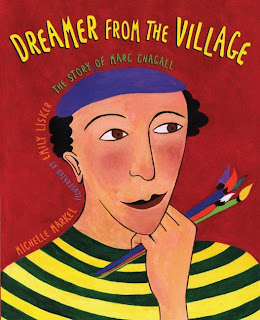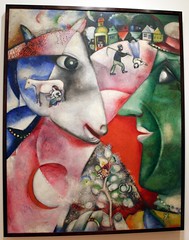
Lewis, J. Patrick and Jane Yolen. 2011.
Self Portrait with Seven Fingers: The Life of Marc Chagall in Verse. Mankato, MN: Creative Editions.
pairs the art of Marc Chagall with the talent of writers, Jane Yolen and Patrick L. Lewis, for a result that is illuminating in every sense of the word.
"There's never been anybody since [Pierre-Auguste] Renoir who has the feeling for light that Chagall has," Pablo Picasso once said. "[W]hen [Henri] Matisse dies, Chagall will be the only painter left who understands what color really is." Chagall himself wrote that "there is a single color ... which provides the meaning of life and art. It is the color of love."
Such is the praise that Chagall received from his contemporaries and is related in
Self-Portrait. Marc Chagall's use of color and light makes his work particularly appealing to children. Chagall's art is the ingredient from which dreams may be made; and dreams and colors are things that children know intimately. But aside from a child's natural attraction to Chagall's colorful paintings on a purely visceral level, Patrick Lewis and Jane Yolen make Chagall's art accessible through words, poetry, history, and examination.
Paintings or works are presented in roughly chronological order, each chosen to represent a period in Chagall's life. Each is paired with a poem by Yolen or Lewis, which gives context and definition to both the artwork and Chagall's life. Opposite "My Fiancee in Black Gloves," Yolen writes, borrowing words from Chagall's first wife, Bella Rosenfeld.
"I was surprised at his eyes,
they were so blue as the sky,
and oblong, like almonds,"
Bella writes, and having written,
falls in love, she so young and rich,
and he but a poor apprentice,
working for a Russian painter
he will one day eclipse,
a sun over Bakst's pale moon.
Did she know how he would rise
like an angel into the sky
on that first day they met,
having tea at Teja's house,
or the next time on the bridge
when he and Teja walked the dog,
and Marc's curly hair spilling
out from under his hat.
Or did she just fall in love
with the surprise of his blue eyes?
Each poem is accompanied by a shaded box, offering facts about each particular period in Chagall's life, including his home, marriage, paintings, colleagues, friends, and the effects of war, politics and circumstances on his very existence and his work.
Yolen's poetic additions to
Self-Portrait with Seven Fingers ("with seven fingers" is a Yiddish phrase meaning "done well" or "adroitly done") are free-form in nature when compared with Lewis' more measured and often rhyming verse, however, all flow seamlessly and complement Chagall's work, sometimes inviting deeper exploration of the painting - offering almost a "seek-and find" challenge to the reader,
From "I and the Village"
I hailed a milkmaid standing on he

Shana Tova! Happy New Year! In honor of the Jewish New Year, I have been inspired to reach out to our wonderful community of writers and other supporters of Jewish literature for children. Since the publication of Like a Maccabee, I have had the opportunity to meet so many terrific folks, from librarians to writers and editors. I’m excited to share some of their insights and contributions.
I am pleased and proud to introduce my friend and SCBWI colleague, Michelle Markel. Michelle has written several picture books, both fiction and non-fiction. Her passion for art is evident in her newest book, a colorful biography about artist Marc Chagall.
Why were you drawn to write Dreamer From the Village: The Story of Marc Chagall?
Several reasons. I felt a connection to Chagall because of my Jewish roots, because my grandparents came from the Ukraine, as he did. I thought his art would appeal to children because it’s dreamlike, very emotional, full of vivid colors and flying magical beasts- what’s not to like? Thematically I was drawn to the story because it’s one of perseverance, of believing in oneself even when others don’t.
How did you to find the right publisher for the book?
I had a manuscript consultation at an SCBWI conference where an agent told me I’d need to find a Jewish editor for the book, which I ignored. A non-Jewish editor took interest in the story, and had me revise it a couple of times but ultimately passed on it. By total serendipity, the new improved version found its way to the desk of Marc Aronson at Henry Holt. Aronson was named after Marc Chagall- his father, a set designer, knew the artist in Russia and wrote about him before emigrating to the U.S. So the agent was right; the story was destined for a Jewish editor.
Who are some of your influences?
For biography, I was greatly inspired by Jonah Winter’s Diego. I picked up that book in the library when my girls were little. I thought it was as a magical little story about an artist, and it wasn’t until I came to the part where striking workers got shot that I realized it was a nonfiction book about Diego Rivera! It was a revelation to find a nonfiction book with spare, lyrical language.
What are the challenges of writing picture book biographies?
To distill the essence of your subject, you have to do nearly as much research as if you’re writing an adult biography. You have to decide on your themes, and then choose only the facts that support them. It’s hard to part with fun little details you’ve uncovered. It may be interesting that the young Chagall used to put rouge on his cheeks because he thought it made him more attractive. It’s amusing that early in his career he used to paint buck-naked. But when you’re writing a 1000 word picture book bio, you have to streamline the narrative.
Do you prefer writing fiction or non-fiction?
I like the total freedom of writing fiction, and watching my characters sculpt themselves out of thin air. I like the discovery process of non-fiction research, and that moment when I figure out the angle- how to make the subject enticing to kids. My book Dream Town has a little of both, so it’s what you’d call creative non-fiction.
Why did you start writing children's books?
I loved picture books as a child, especially Madeline. (I loved the spunky heroine and the jewel-tone colors of the illustrations, and found out only recently that Ludwig Bemelmans was influenced by the Fauves, as was Chagall!). After my daughters were born I discovered William Steig, Dayal Khalsa, Petra Mathers, Allen Say and other great writers. Since I’d worked as a freelance journalist, and already had writing experience, I had the nerve to think I could contribute something to the field.
What are you currently working on?
I’ve been researching certain Jewish women who fought for a better world. That’s all I can say for now.
What is the hardest part about being a writer?
For me, the challenge has been to find the right editor for my projects. I’ve written in several genres (fiction, non-fiction, creative non-fiction, biography) and have had to find the right person for each one of them.
What is the best thing about being a children's writer?
Since our audience is at an impressionable age, we’re in the position of making a big impact on our readers. And what a great audience they are! No one is more generous with praise than children. Call me a softie, but after a school visit I can never get enough of those crayon and construction paper cards that say "I Love You."
What are your hobbies? .
I go to art exhibits, concerts, hang around in bookstores, shop at Trader Joe’s.
What’s next?
My newest title is The Shark That Taught Me English, about an immigrant girl from Mexico (Lectura Books). It’s going to be a bilingual picture book, which I think is extremely cool.
Fun Facts about Michelle: She has worked as an au pair in France, and was translator for the 1984 Olymipcs!
Michelle, thanks for taking the time to book talk with me. It's been a pleasure!
Rebecca OUP-US
Today we are thrilled to have an original piece from Paul Collier the author of The Bottom Billion: Why the Poorest Countries Are Failing and What Can Be Done About It. Below, Collier a Professor of Economics and Director of the Center for the Study of African Economies at Oxford University, argues that the G8 did not go far enough in its efforts to assist Africa.
Since the 1960s around a billion citizens of the world have been diverging from the rest of us at an accelerating rate, a trend which will generate unmanageable social pressures. Most of these countries are in Africa, and so it is appropriate that the region should again have been on the G8 agenda during the recent summit in Germany. (more…)
Share This
 Lewis, J. Patrick and Jane Yolen. 2011. Self Portrait with Seven Fingers: The Life of Marc Chagall in Verse. Mankato, MN: Creative Editions.
Lewis, J. Patrick and Jane Yolen. 2011. Self Portrait with Seven Fingers: The Life of Marc Chagall in Verse. Mankato, MN: Creative Editions.




What an interesting concept, pairing poem to artwork. This would be perfect for an Art Masterpiece project, too. I'm getting ideas already...
While I do enjoy the occasional picture book portrayal of scientists and mathematicians - I have a soft spot for writers, poets, musicians, and artists. And this book has captured me from the get-go. I LOVE the concept - and the promise of 'exquisite' illustrations. I would not have known about this book if we had not joined Nonfiction Monday. Thank you for sharing this.
I've found many great books via Nonfiction Monday, too! Thanks for stopping by. I'm happy to spread the word about this unique book. Lisa